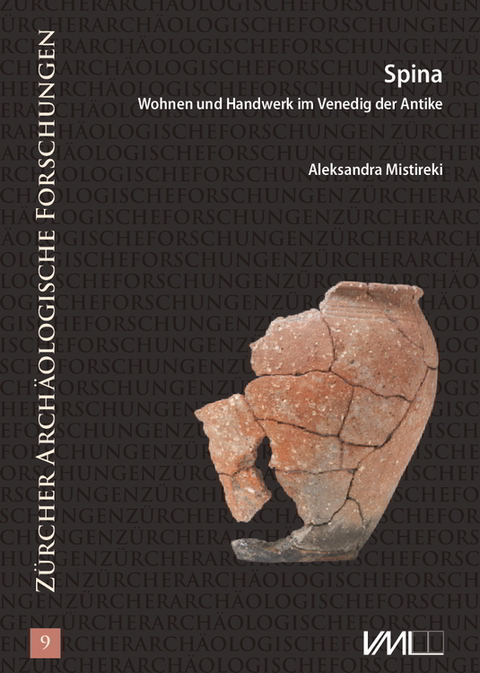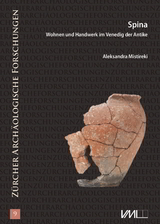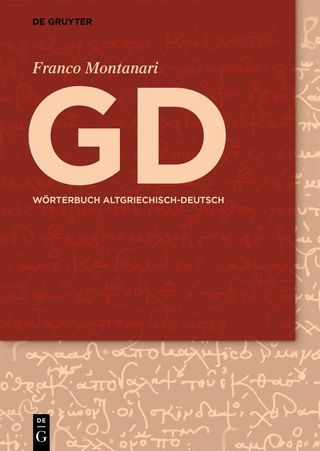Spina - Wohnen und Handwerk im Venedig der Antike
Zur Rekonstruktion eines Hauses und dessen Ausstattung im 4. Jh. v. Chr.
Seiten
2023
|
1., Aufl.
VML Vlg Marie Leidorf (Verlag)
978-3-86757-669-7 (ISBN)
VML Vlg Marie Leidorf (Verlag)
978-3-86757-669-7 (ISBN)
Die Zürcher Ausgrabungen in Spina [2008-2017] förderten mehrere Siedlungsphasen vom Ende des 6. bis zum Ende des 4. Jhs. v.Chr. zu Tage. Der vorliegende Band widmet sich den Überresten der jüngsten Phase, einem während einer kriegerischen Auseinandersetzung zerstörten Haus und dessen vollständig erhaltenem Inventar des 4. Jhs. v.Chr. Neben der Auswertung der architektonischen Überreste wird auch das Fundmaterial vollumfänglich präsentiert, wobei insbesondere die in der Forschung bisher kaum betrachtete sog. Gebrauchskeramik ins Zentrum gerückt wird. Anhand der Analyse des Fundmaterials werden Rückschlüsse zur Organisation des Haushaltes sowie dem Konsumverhalten und der gesellschaftlichen Stellung der Bewohner:innen gezogen. Zudem wird die Funktion, typologische Entwicklung, Herstellungsweise, chronologische Entwicklung und die Herkunft des keramischen Fundmateriales untersucht. Das bisher in der Po-Ebene nur spärlich dokumentierte 4. Jh. v.Chr. wird durch die Untersuchungen im historisch als wichtigsten Handelsumschlagplatz der italienischen Adriaküste überlieferten Spina um neue Daten zur materiellen und sozialen Vernetzung im Mittelmeerraum erweitert und ermöglicht Dank hervorragender Erhaltungsbedingungen und des ungestörten Befundes einen wichtigen Beitrag zur chronologischen Einteilung und typologischen Entwicklung der etruskischen Keramik und dem Siedlungswesen dieser Zeit.
The Zurich excavations in Spina [2008-2017] brought to light several settlement phases from the end of the 6th to the end of the 4th century B.C. The present volume is dedicated to the remains of the most recent phase, a house destroyed during a military conflict and its completely preserved inventory of the 4th century B.C. In addition to the evaluation of the architectural remains, the findings are also presented in their entirety, focusing on the so-called utilitarian pottery, which has hardly been considered in research to date. Based on the analysis of the findings, conclusions are drawn about the organisation of the household as well as the consumer behaviour and the social position of the inhabitants. In addition, the function, typological development, method of production, chronological development and origin of the ceramic findings are examined. The investigations in Spina, historically the most important trading centre on the Italian Adriatic coast, have added new data on the material and social network in the Mediterranean to the previously only sparsely documented 4th century B.C. in the Po Valley. Thanks to the excellent preservation conditions and the undisturbed features, the study makes an important contribution to the chronological classification and typological development of Etruscan pottery and the settlement system of this period. The Zurich excavations in Spina [2008-2017] brought to light several settlement phases from the end of the 6th to the end of the 4th century B.C. The present volume is dedicated to the remains of the most recent phase, a house destroyed during a military conflict and its completely preserved inventory of the 4th century B.C. In addition to the evaluation of the architectural remains, the findings are also presented in their entirety, focusing on the so-called utilitarian pottery, which has hardly been considered in research to date. Based on the analysis of the findings, conclusions are drawn about the organisation of the household as well as the consumer behaviour and the social position of the inhabitants. In addition, the function, typological development, method of production, chronological development and origin of the ceramic findings are examined. The investigations in Spina, historically the most important trading centre on the Italian Adriatic coast, have added new data on the material and social network in the Mediterranean to the previously only sparsely documented 4th century B.C. in the Po Valley. Thanks to the excellent preservation conditions and the undisturbed features, the study makes an important contribution to the chronological classification and typological development of Etruscan pottery and the settlement system of this period.
The Zurich excavations in Spina [2008-2017] brought to light several settlement phases from the end of the 6th to the end of the 4th century B.C. The present volume is dedicated to the remains of the most recent phase, a house destroyed during a military conflict and its completely preserved inventory of the 4th century B.C. In addition to the evaluation of the architectural remains, the findings are also presented in their entirety, focusing on the so-called utilitarian pottery, which has hardly been considered in research to date. Based on the analysis of the findings, conclusions are drawn about the organisation of the household as well as the consumer behaviour and the social position of the inhabitants. In addition, the function, typological development, method of production, chronological development and origin of the ceramic findings are examined. The investigations in Spina, historically the most important trading centre on the Italian Adriatic coast, have added new data on the material and social network in the Mediterranean to the previously only sparsely documented 4th century B.C. in the Po Valley. Thanks to the excellent preservation conditions and the undisturbed features, the study makes an important contribution to the chronological classification and typological development of Etruscan pottery and the settlement system of this period. The Zurich excavations in Spina [2008-2017] brought to light several settlement phases from the end of the 6th to the end of the 4th century B.C. The present volume is dedicated to the remains of the most recent phase, a house destroyed during a military conflict and its completely preserved inventory of the 4th century B.C. In addition to the evaluation of the architectural remains, the findings are also presented in their entirety, focusing on the so-called utilitarian pottery, which has hardly been considered in research to date. Based on the analysis of the findings, conclusions are drawn about the organisation of the household as well as the consumer behaviour and the social position of the inhabitants. In addition, the function, typological development, method of production, chronological development and origin of the ceramic findings are examined. The investigations in Spina, historically the most important trading centre on the Italian Adriatic coast, have added new data on the material and social network in the Mediterranean to the previously only sparsely documented 4th century B.C. in the Po Valley. Thanks to the excellent preservation conditions and the undisturbed features, the study makes an important contribution to the chronological classification and typological development of Etruscan pottery and the settlement system of this period.
| Erscheinungsdatum | 05.07.2023 |
|---|---|
| Reihe/Serie | Zürcher Archäologische Forschungen ; 9 |
| Verlagsort | Rahden/Westf. |
| Sprache | englisch; deutsch; italienisch |
| Maße | 210 x 297 mm |
| Gewicht | 1920 g |
| Einbandart | gebunden |
| Themenwelt | Geschichte ► Allgemeine Geschichte ► Altertum / Antike |
| Schlagworte | Etruria padana • Handwerk • Haushalt • Holzarchitektur • Keramik |
| ISBN-10 | 3-86757-669-6 / 3867576696 |
| ISBN-13 | 978-3-86757-669-7 / 9783867576697 |
| Zustand | Neuware |
| Haben Sie eine Frage zum Produkt? |
Mehr entdecken
aus dem Bereich
aus dem Bereich
die Inszenierung der Politik in der römischen Republik
Buch | Hardcover (2023)
C.H.Beck (Verlag)
48,00 €
Buch | Hardcover (2024)
Klett-Cotta (Verlag)
50,00 €




